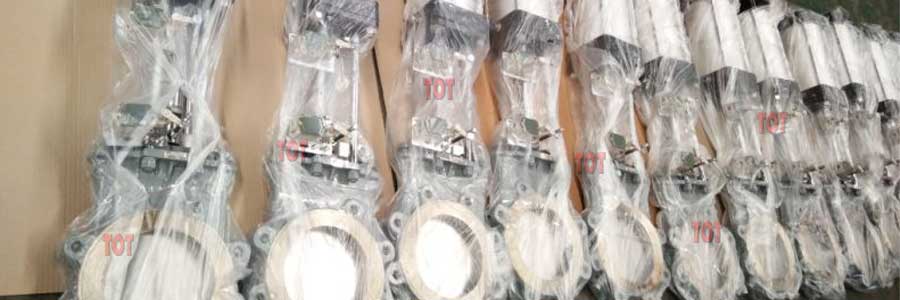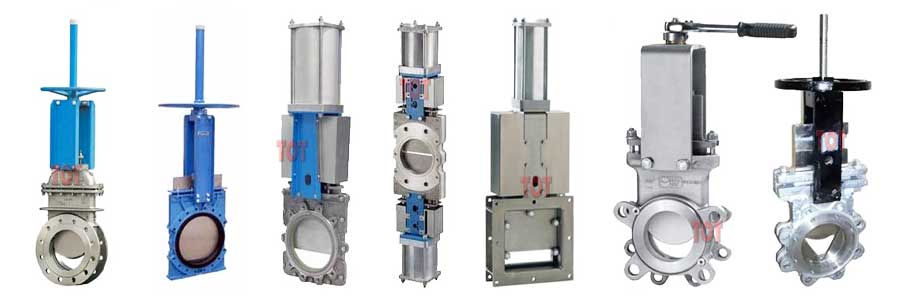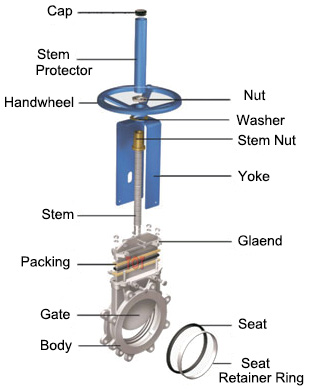
When your industrial operation demands reliable shut-off performance in tough environments, knife gate valves are often your best choice. But with so many types, materials, and actuation methods available, how do you select the right knife gate valve for your system?
In this guide, you’ll gain a complete understanding of knife gate valves—from their core functions and types to price factors and selection tips—helping you make an informed decision that optimizes your flow control.
Table of Contents
ToggleWhat is a Knife Gate Valve?
A knife gate valve also called knife valve, is specifically engineered for on-off and isolation services, particularly in systems that handle slurry, viscous, corrosive, or abrasive media. Thanks to its sharpened blade, a knife gate valve can cut through thick flows with minimal pressure drop when fully opened.
You should note that knife gate valves are not designed for flow regulation. Using them partially open may cause vibration and erosion of the disc and seat, leading to valve failure over time. That’s why in your operation, you should always use knife gate valves either completely open or completely closed.
Knife Gate Valve Types – Choose the Right Structure for Your System
Depending on your application, different types of knife gate valve designs we offer, each offering unique benefits:
- Wafer Style Knife Gate Valve: Compact and lightweight, ideal for space-restricted installations.
- Lugged Knife Gate Valve: Provides easy installation between flanges and supports dead-end service.
- Flanged Knife Gate Valve: Offers robust mechanical connection, often used in heavy-duty industries.
- Bonneted Knife Gate Valve: Features a sealed body for applications requiring zero leakage to the atmosphere.
- Through Conduit Knife Gate Valve: Allows unobstructed media flow, ideal for highly abrasive slurries.
- Double Knife Gate Valve: Designed for bidirectional sealing, perfect for slurry or slurry-like media under backpressure.
- Square Port / V Port / O Port Knife Gate Valve: Special-shaped ports accommodate unique flow requirements.
- Rising Stem vs Non-Rising Stem: Rising stems provide visual position indication, while non-rising stems save vertical space.
- Severe Service Knife Gate Valve: Built with reinforced seats and blades to withstand extreme abrasion, corrosion, and temperature.
By understanding these types, you can ensure that your knife gate valve matches both your space limitations and your media characteristics.

Actuated Knife Gate Valve Options – Manual or Automated Operation?
How your knife gate valve operates matters significantly to your system’s efficiency. Here’s how different actuation methods compare:
- Manual Knife Gate Valve: Ideal for simple, infrequent operation where manual labor is acceptable.
- Pneumatic Knife Gate Valve: Powered by compressed air, these valves offer fast, reliable operation, perfect for repetitive cycling.
- Hydraulic Knife Gate Valve: Suited for large-diameter or high-pressure systems where strong force is required.
- Electric Knife Gate Valve: Best for remote or automated systems where precise control and monitoring are essential.
Choosing the right actuation depends on your plant’s energy availability, system size, and automation needs.
Material & Construction – Built for Harsh Media
Selecting the right valve material is crucial to achieving long-term performance, especially in aggressive environments:
- Stainless Steel Knife Gate Valve: Provides excellent corrosion resistance, suitable for chemical, food-grade, or wastewater industries.
- Ceramic Knife Gate Valve: Designed for severe abrasion environments such as mining, power generation, and slurry transport.
- Sanitary Knife Gate Valve: Manufactured for hygienic processes like food, beverage, or pharmaceutical production, often polished internally.
- High Temperature Knife Gate Valve: Equipped with heat-resistant seals and materials to withstand extreme process temperatures.
- High Pressure Knife Gate Valve: Reinforced body and seals handle pressure spikes and sustained high-pressure operation.
- Heavy Duty Knife Gate Valve: Designed with thick blades and hardened seats to endure frequent cycling in harsh media.
What are Parts of Knife Gate Valves?
When choosing materials, you should always match your valve’s corrosion, abrasion, and temperature resistance to your specific process fluid.
The major flow parts are the body, gate, and seat, while the supporting components like the stem, packing, gland, and actuator make sure the valve operates reliably and seals tightly. A knife gate valve typically consists of the following key parts:

Body
The outer structure that houses all internal components. Usually made of materials such as cast iron, stainless steel or carbon steel. Designed to withstand external pressure and mechanical stress.
Gate (Knife)
The flat, sharpened plate that moves up and down to control the flow. Its “knife” edge is specifically designed to cut through slurry, thick fluids, or solid-laden media.
Seat
The surface inside the valve body that the gate presses against when closed to create a tight seal. May be soft-seated (rubber, PTFE), ceramics or metal-seated depending on the application.
Stem
The rod that connects the actuator (or handwheel) to the gate, transmitting motion. It can be rising (stem moves up/down) or non-rising (stem remains stationary, gate moves internally).
Packing
Sealing material around the stem where it passes through the valve body. Prevents leakage along the stem and protects against media escaping.
Gland
The mechanical assembly that compresses the packing material around the stem. Ensures a tight seal even when the stem moves.
Bonnet (Optional)
A cover that encloses the stem and packing area for added protection, especially in high-pressure or hazardous applications. Not all knife gate valves have a bonnet (bonnetless designs are common for easier maintenance).
Actuator or Handwheel
The device used to operate the valve (open/close). Options include manual handwheels, pneumatic cylinders, hydraulic actuators, or electric actuators.
Yoke
A support structure that holds the actuator or handwheel in place above the valve body. Provides stability and proper alignment for smooth valve operation.
Seals and O-rings
Various sealing elements used throughout the valve to ensure leak-tight performance, especially between the body, gate, and stem.
Applications – Where Knife Gate Valves Perform Best

Knife gate valves are widely used in many industries. We have a stable and reliable series of knife gate valves to meet the needs of your harsh working environment and promise to reduce downtime of your system in an economical way. The particularly where slurry or viscous flows are involved:
- Slurry Systems: Mining, tailings, and mineral processing plants depend on slurry knife gate valves to handle dense, abrasive flows.
- Industrial Processing: Pulp and paper mills, chemical plants, and cement factories use knife gate valves for reliable isolation of thick media.
- Water & Wastewater Treatment: Knife gate valves excel in wastewater systems, especially when corrosion-resistant stainless steel materials are used.
- Heavy Oil and Viscous Fluids: Knife gate valves’ unobstructed flow path and cutting action make them ideal for heavy oils and other viscous fluids.
You can find knife gate valves operating efficiently in some of the harshest industrial environments globally.
How to Choose the Right Knife Gate Valve Manufacturer?
Selecting a trusted knife gate valve manufacturer is as important as choosing the valve itself. Here’s what you should look for:
- Industrial Focus: The manufacturer should have proven experience with slurry, viscous, or corrosive media.
- Material Expertise: Ability to offer multiple material options, including stainless steel and ceramic, for different applications.
- Customization Capability: Support for non-standard designs, large diameters, or unique operating pressures and temperatures.
- International Certifications: Compliance with API, MSS-SP, or other recognized standards is critical for global projects.
- After-Sales Support: Reliable technical assistance and spare parts availability ensure the longevity of your system.
At TOT Valve, we specialize in manufacturing industrial-grade knife gate valves tailored to your specific needs. Whether you need a heavy-duty ceramic knife gate valve for mining, a sanitary stainless steel valve for food processing, or a high-temperature valve for power plants, we have you covered.
Conclusion
Knife gate valves are indispensable in industries dealing with slurry, viscous fluids, and challenging environmental conditions. Because knife gate valves vary in design, material, and actuation, careful consideration is required when selecting the right valve for your operation.
By understanding your system’s demands and working with an experienced manufacturer like TOT Valve, you can ensure maximum reliability, minimum downtime, and optimal flow control performance.
Are you looking for a reliable knife gate valve manufacturer in China? Contact TOT Valve today and find the perfect solution for your industrial flow challenges!
FAQ
How Does a Knife Gate Valve Work?
You operate a knife gate valve by lifting or lowering a sharp-edged blade (the “knife”) to control flow. When you open the valve, the gate lifts clear of the flow path, allowing fluid or slurry to pass through freely. When you close it, the gate drops down, forming a tight seal against the seats to stop flow completely.
What Are Knife Gate Valves Used For?
You will find knife gate valves essential when you need to manage thick, viscous, or solid-laden fluids. They are primarily used for on-off and isolation services where clean and reliable shutoff is critical — especially in harsh, abrasive, and slurry-filled environments.
Whenever you deal with fluids that contain suspended solids, abrasive particles, or heavy sludge, a knife gate valve gives you reliable shutoff without clogging or excessive wear.
It’s especially useful where corrosion resistance, minimal pressure drop, and easy maintenance are also important to your operation.
What Industries Use Knife Gate Valves?
Knife gate valves are vital across many industries, including:
- Pulp and Paper
- Mining and Slurry Processing
- Wastewater Treatment
- Chemical Processing
- Cement and Power Generation
- Food and Beverage (with sanitary designs)
You’ll find them invaluable wherever suspended solids or heavy media need reliable flow control.
Can Regulate Flow with a Knife Gate Valve?
Generally, no. You should only use a knife gate valve for fully open or fully closed positions. Partially opening it can cause vibration, erosion, and premature damage to the valve seat and body. If you need throttling capability, it’s better to choose a valve specifically designed for that purpose.
What Material is a Knife Gate Valve?
Depending on your application, you’ll find knife gate valves made from:
- Stainless Steel (for corrosion resistance)
- Carbon Steel
- Ductile Iron
- Ceramic-lined (for severe abrasion)
- Sanitary-grade stainless steel (for food and pharma industries)
Choosing the right material ensures maximum performance and lifespan.
What Influences Knife Gate Valve Cost?
Understanding the factors that impact knife gate valve pricing helps you budget more accurately:
- Material: Stainless steel and ceramic models cost more than cast iron or carbon steel variants.
- Size: Larger diameters naturally drive higher costs due to more material and stronger construction requirements.
- Design Complexity: Options like bonneted designs or double-sealing constructions come at a premium.
- Actuation Method: Electric and hydraulic actuators increase the overall price compared to manual or pneumatic types.
- Customization: If you require special port shapes, face-to-face dimensions, or compliance certifications (e.g., API, MSS), the cost will be higher.
By balancing your system needs with your budget, you can select a valve that delivers the best return on investment over its service life.
Why Choose a Knife Gate Valve Over a Traditional Gate Valve?
You should choose a knife gate valve when you deal with:
- Slurries or media with high solid content
- Viscous, abrasive, or corrosive materials
- Applications where space and weight are concerns (knife gate valves are more compact and lightweight)
Compared to traditional wedge gate valves, knife gate valves offer better performance in these challenging environments.
How Can You Extend the Life of a Knife Gate Valve?
To maximize your valve’s lifespan, you should:
- Select the right valve type and material for your specific media and pressure conditions.
- Avoid throttling (partial opening) unless the valve is designed for it.
- Regularly inspect and maintain packing, seals, and seats.
- Operate the valve slowly to minimize water hammer effects.
Proper selection and maintenance ensure your valve delivers reliable, long-term service.
